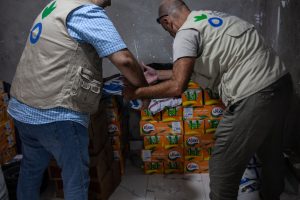

Your browser is not up to date.
If you wish to view the Action Against Hunger website correctly, update your browser.
Find the latest versions of supported browsers listed below.
No matching results…
No results seem to match what you are looking for, please modify your search.
 © Action contre la Faim
© Action contre la Faim
Headline
More than 25 days after the start of the war, extreme constraints to safe and sustained access to water in Gaza continue to threaten the lives of thousands of families according to Action Against Hunger, the Norwegian Refugee Council, Oxfam, Care and WeWorld.
Between 16 and 24 October, the Water, Sanitation and Hygiene Cluster (WASH) estimated that the population had access to only 1 to 3 litres of water per day to meet all their needs. This shortage raises fears of dehydration, kidney failure and other critical health consequences, especially for already vulnerable people.
In the last week, the WASH Cluster has reported a slight increase in the daily amount of water available. This fluctuation in daily water availability is based on a number of factors including the ability to safely transport existing water supplies, the functionality of Israeli water pipelines and the emergency fuel reserves available for the two remaining operational seawater desalination plants, which are currently operating at 5-40% of capacity, according to the UN.
Women, especially pregnant or lactating women, along with children, face increased risks due to lack of adequate water and sanitation. Children under 5 years of age are more susceptible to waterborne diseases due to contaminated water and inadequate hygiene. Lack of water makes it difficult to manage menstruation in a hygienic and dignified manner, leading many women and girls to use menstrual products for longer than intended, increasing the risk of infection.
Fuel has still not entered the Strip, even though Gaza’s basic water infrastructure require a daily minimum of 30,000 litres of fuel to function. The lack of fuel has led to the total closure of sewage treatment plants, resulting in the daily discharge of more than 130,000 cubic metres of raw sewage into the Mediterranean Sea, a serious environmental hazard. About 80 per cent of Gaza’s water supply is from wells and underground aquifers, which require fuel for extraction and desalination. Most water tankers are empty of fuel, and residents resort to donkeys to transport the limited water supply available.
Despite the dire needs facing Gazan families, between 21 October and 1 November, only 26 truckloads of life-saving water and sanitation supplies entered Gaza, according to OCHA, which is nowhere near enough to cover the population’s essential survival needs.
While on 29 October the Israeli authorities confirmed their intention to resume water supplies to central Gaza and gave the green light to the Palestinian Water Authority (PWA) to repair a critical water pipeline, it remains uncertain whether the PWA has the necessary resources, security conditions, supplies and qualified personnel to carry out these repairs effectively. Once operational, this pipeline could significantly improve the availability of drinking water in the area. In contrast, the water supply from Israel to the western part of Khan Younis, which was reconnected on 15 October, was interrupted on 30 October for unclear reasons. The third pipeline from Israel to northern Gaza has remained closed since 8 October.
Meanwhile, access to water in the West Bank, especially for remote communities in Area C, is increasingly at risk. The Consortium for the Protection of the West Bank reports that some communities are suffering water shortages due to Israeli checkpoints and road closures. In addition, there is an increase in settler violence against water and sanitation systems. This includes damage to the main water pipeline for residents of Masafer Yatta in the South Hebron Hills, destruction of water storage tanks, and restrictions on movement and access preventing locals from reaching their primary water sources.
Since 7 October, the humanitarian crisis in Gaza has deteriorated significantly due to the escalation of hostilities. Exacerbated by 16 years of blockade and multiple previous rounds of devastating escalations of violence, the Gaza Strip now faces catastrophic needs for water, sanitation and hygiene, essential for the survival of its 2.3 million inhabitants, half of whom are children.


Occupied Palestinian Territory
All the news of our Action: articles, events, testimonials, press releases…